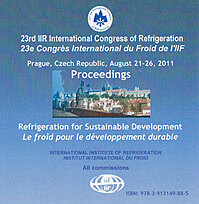
IIR document
Indoor air quality problems in passive buildings.
Number: pap. ID: 356
Author(s) : MÜLLER J., SKRZYNIOWSKA D.
Summary
There are various contaminants in habitable buildings (from people, animals, equipment, lighting, etc.). In standards and regulations, one can find minimum airflow required for ventilation according to indoor air quality category. Poland is not the only country where natural ventilation is one of the most popular types of ventilation systems. Natural ventilation does not always work properly, does not supply required airflow. Therefore, there are symptoms of Sick Building Syndrome, excessive amount of carbon dioxide and water vapor and a risk of carbon monoxide presence. The idea of passive buildings is to minimize energy loss to the environment therefore new designed passive buildings have 100%: sealed windows, doors, walls. Passive buildings need mechanical ventilation systems but owners do not always install such system because of some disadvantages (noise, space for ductwork, air handling unit, intake and exhaust opening, investment cost etc.). The paper presents short characteristics of air pollution in average building, simple calculation of energy required for ventilation and some real problems with mechanical ventilation systems.
Available documents
Format PDF
Pages: 7 p.
Available
Public price
20 €
Member price*
Free
* Best rate depending on membership category (see the detailed benefits of individual and corporate memberships).
Details
- Original title: Indoor air quality problems in passive buildings.
- Record ID : 30002724
- Languages: English
- Source: Proceedings of the 23rd IIR International Congress of Refrigeration: Prague, Czech Republic, August 21-26, 2011. Overarching theme: Refrigeration for Sustainable Development.
- Publication date: 2011/08/21
Links
- See translations: Problemas de calidad del aire interior en los edificios pasivos.
See other articles from the proceedings (569)
See the conference proceedings
Indexing
-
Themes:
Indoor air quality;
Comfort air conditioning - Keywords: Sick building; Building; Ventilation; Passive cooling; Air quality; Poland; Air conditioning
-
Natural ventilation and automation with manual ...
- Author(s) : PAASSEN A. H. C. van, LUTE P. J.
- Date : 1992/02/17
- Languages : English
View record
-
Small air ions and indoor air quality.
- Author(s) : MARTINAC I.
- Date : 1995/05/01
- Languages : English
- Source: 1995 AIRAH Conference Proceedings.
View record
-
Pollution source control and ventilation improv...
- Author(s) : WARGOCKI P., WYON D. P., FANGER P. O.
- Date : 2000/11/22
- Languages : English
- Source: DKV-Tagungsbericht Bremen. 2000.
View record
-
Indoor air quality in the Shanghai air-tight of...
- Author(s) : SHEN J., YAN J.
- Date : 1997/09/09
- Languages : English
- Source: International Symposium on Air Conditioning in High Rise Buildings - 1997
- Formats : PDF
View record
-
Long term monitoring of residential heat recove...
- Author(s) : CREMERS B.
- Date : 2013/06/16
- Languages : English
- Source: Clima 2013. 11th REHVA World Congress and 8th International Conference on Indoor Air Quality, Ventilation and Energy Conservation in Buildings.
- Formats : PDF
View record
